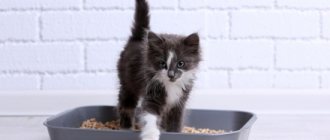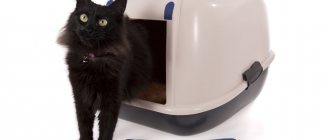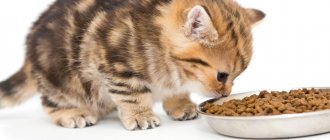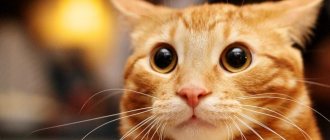A tray for a small pet is an essential item. The success of toilet training a kitten largely depends on the correct choice of litter box. The modern pet industry offers a huge number of different models: from the simplest and most budget-friendly to the super-functional and expensive. In order not to get confused in the store, it is useful to get acquainted with the advantages and disadvantages of different models in advance.
What to consider when choosing?
When choosing a model, you need to take into account not only the preferences of your little pet, but also the ease of use of the tray for humans: cleaning, absorption of unwanted odors, transportability. It is important to immediately decide on the location for the toilet so that you know what size will suit you. Experienced breeders give the following recommendations:
- The kitten should easily climb into the container, so you need to choose a height for the sides so that they do not become an obstacle for the baby. Otherwise, he may relieve himself not in the right place, but nearby.
- Size is very important: it should not constrain the animal.
- It is better to decide in advance on the type of model - open or closed.
- Pallets made of lightweight plastic are easily overturned, so it is better to choose more stable options.
- If the model is difficult to care for, it is not easy to wash it and remove the filler, it is better to abandon it. Cats are very clean and can ignore a poorly cleaned litter box.
The cost of an accessory does not always determine the right decision. The most important points are comfort and suitable size. If the tray is inconvenient for the baby, the process of toilet training will be delayed and will require additional effort and time from you.
Rating of the best indoor toilets for cats
| Nomination | place | Name of product | price |
| The Best Inexpensive Indoor Litter Boxes for Cats | 1 | Moderna Trendy Cat Cats In Love | 1 859 ₽ |
| 2 | MPS Netta 54x39x40 cm | 1 240 ₽ | |
| 3 | HOMECAT 53x39x42cm | 1 446 ₽ | |
| 4 | SAVIC Duchesse 44.5x35.5x32 cm | 734 ₽ | |
| The best indoor toilets in the mid-price segment | 1 | Curver PetLife 51*39*40cm | 3 572 ₽ |
| 2 | Ferplast Maxi Bella 50x47x65.5 cm | 4 570 ₽ | |
| 3 | Toilet box N1 Mak 102 | 3 255 ₽ | |
| The best indoor toilets for cats in the premium segment | 1 | Cat Genie 120 | 34 900 ₽ |
| 2 | PetSafe ScoopFree Ultra 70.2x40.6x48.6 cm | 17 995 ₽ | |
| 3 | Pidan "IGLU" | 7 900 ₽ |
Plastic tray with low sides
This is the most popular option. It is as simple as possible, it looks like a plastic pallet with sides of different heights and shapes.
Advantages:
- does not create obstacles for the kitten, as it is convenient to climb into it;
- inexpensive, therefore, if necessary (violation of integrity, the appearance of a persistent odor that cannot be gotten rid of), it can easily be replaced with a new one;
- convenience when replacing the filler, which can be easily poured into a bag or drain;
- easy to clean – a one-piece open container without additional parts can be washed without difficulty;
- transportability – plastic products are lightweight and compact, they can easily be moved or taken on a trip.
Flaws:
- does not protect against scattering of filler due to low sides;
- The plastic is quite soft, so over time it will inevitably develop scratches that cannot be washed out;
- requires the mandatory use of filler;
- Does not block unwanted odors.
One of the modifications is a pot with sides curved inward. It is more practical, as it prevents the filler from spreading, but is less practical to maintain. It is not easy to wash the inner surface of such sides, and it is not always possible to shake out the dirty filling right away: the pieces fall under the bend, and it is difficult to get rid of them without additional equipment.
Plastic toilet with grate
It is a regular plastic tray with a mesh insert inside. We can say that this is an improved modification of a simple tray.
Advantages:
- the grid protects the kitten’s paws from getting wet, so all the liquid flows to the bottom;
- solid feces remain on the mesh and can be easily removed with a dustpan;
- easy to clean: both the tray and the grill can be easily washed with a stream of water;
- the filler does not spread around and does not stick to the cat’s paws, that is, it does not spread throughout the apartment, as it is usually poured under the net.
Flaws:
- does not block unpleasant odors without filler;
- It is more difficult to clean than usual, since it consists of two parts;
- Disliked by cats who prefer to bury excrement.
The option with a grid involves a little trick: you can pour just a little heavy filler (mineral, silica gel or clumping) onto the grid, and a well-absorbing filler under the grid. This way the cat will have something to scratch, but the smell will remain in the lower part of the tray and will not spread throughout the house.
Types of trays
Traditional (ordinary) tray
This model of cat litter is a standard plastic tray with low sides, usually a laconic rectangular shape with straight or slightly rounded corners; corner (triangular) types of litter are less common. The absence of a grid implies the mandatory use of filler. We talked about how to choose the right type of filler in this article.
| pros | Minuses |
| a small, narrow tray that doesn't take up much space | mandatory use of filler |
| cheap option, which allows you to change trays more often | does not retain odor (especially for solid pet feces) |
| convenient replacement of filler | When the cat digs and does other active activities, the litter will easily fall out of the toilet |
| easy visual control of cleanliness | unsightly appearance (you and your guests will see everything that is in the tray) |
| easy care of the tray |
Advice! Place a rubberized mat under the tray, this will make the tray more stable and the fallen filler granules will not spread too far.
Open tray with grid
A traditional toilet with a plastic grid-limiter fixed directly above the tray capacity. This design allows you to keep your cat's paws clean, but requires frequent and quick cleaning. A good option for those who do not want to buy litter, however, the cat must also approve of this solution to its needs.
Advice! Take a tray made of thick plastic so that the grid does not press under the weight of the animal, otherwise the cat will soak its paws in its feces. Try to lightly press the grate with your hand and estimate the distance to the bottom of the tray (the optimal value is at least 2 cm).
| pros | Minuses |
| low price | does not retain unpleasant odors at all |
| economical use, because no filler needed | some cats try to dig at the bars with their claws and get caught with them |
| cleanliness around the cat litter | some trays are made of soft plastic that bends under the pet's weight |
| The small size of the tray is not suitable for large cat breeds | |
| frequent cleaning and additional disinfection |
Please note that this model of cat litter makes it difficult to clean up solid feces, as they can dry out between the grid cells.
Tray with sides
Included with the standard plastic tray (with or without a grid) is an additional high side, secured with clips along the edges. This tray is suitable for those owners whose pets often miss the low sides of the toilet and stain the walls, for cats of large breeds and those who like to dig around and scatter litter around the area adjacent to the tray.
If a grate is included in the package, the toilet can be used without filler. If there is no grate, then the most convenient solution is to purchase garbage bags or film and cover the bottom tray with it, press the edges with the sides and at the end add the usual filler. Even a child can clean such a tray; you just need to carefully remove the film with all the contents and lay a new one.
| pros | Minuses |
| protection against spillage of filler | the sides take up extra space and make the tray larger |
| quick cleaning + the ability to use bags | you need to check the quality of the side clamps; sometimes there are very flimsy fasteners |
| stable design (cats like the feeling of security) | |
| suitable for large cats (eg Maine Coons) | |
| reduces the likelihood that your pet will miss the litter box during a bowel movement |
Closed tray house
A type of litter box that will make cats feel protected. It has an aesthetic appearance and can be placed in any room of the apartment, as it holds unpleasant odors inside well. This option is perfect for those who do not want to keep the toilet door constantly open for the cat to access the litter box.
When purchasing, be sure to pay attention to how easily the upper part of the house can be detached from the lower tray. After all, such a house will have to be cleaned as often as open models. The bag-at-the-bottom tip works here too.
These litter boxes come standard with a door, which not all cats accept and use the tray as a personal bed and sleep inside. In such cases, we recommend simply removing the door while they adapt to the new litter box. Alas, such a decision will affect the spread of odor in the room where the toilet is located.
Try showing your pet how the door works several times, especially if you are going to accustom your kitten to a closed type of tray. By the way, we have a detailed guide on how to train a kitten and a cat over 6 months old to use a litter box.
| pros | Minuses |
| the filler does not spread throughout the house | large tray sizes |
| shy and fearful cats are more likely to use closed litter boxes | high price |
| good odor blocking | Periodically you need to wash the top of the tray |
| the pet will definitely not miss and will not go to the toilet next to the tray | it is necessary to unfasten the house to check the cleanliness of the cat litter |
| neat appearance | a cat may refuse to go to the litter box because of the door |
This type of toilet also includes cabinet trays, but they are usually made to order. Caring for such toilets is a little more difficult due to the characteristics of the materials used and design solutions.
Dry toilet for cats
The biotrough is a subtype of closed toilets with the difference that special carbon filters are built into the design of the trough, which perfectly absorb any odors, and a shovel. A replacement filter plate lasts for 5-7 months of use. It is advisable to place a special antibacterial napkin at the bottom of the tray, which will prevent bacteria from multiplying inside the toilet. Such a tray will allow you to change the filling less often, but it is better to remove solid feces immediately.
The cost of such a biological toilet is higher than a closed toilet house, for which you will receive protection from cat odor in the apartment and a drawer for the filler; all other advantages and disadvantages are similar to those described above. On the market, dry toilets for cats are most often represented by Japanese and Italian manufacturers.
Automatic toilets
Know-how in organizing the toilet issue in cats with self-cleaning and a decent price tag. The cat toilet is connected to the sewer system, cold water supply, electrical network, and is an almost completely autonomous device for cleaning cat waste. You will need to think in advance about the place where you decide to place this miracle, but most likely it will be either a toilet or a household room with access to a sewerage system. All the owner will need to take care of after installation is changing the cleaning agent cartridges and purchasing a washable filler.
Cats may be afraid of such a smart litter box, especially if they see the cleaning process, which takes as much as 30 minutes. However, do not worry about the safety of the cat; the sensors will not turn on cleaning when it is directly on the tray.
| pros | Minuses |
| automatic cleaning after each cat's visit to the toilet | separate connection to the water supply and sewerage system |
| filler durability | power consumption |
| disinfection with special detergents safe for pets | noise during filler drying mode |
| Complete protection against cat litter odors in the home | the tray is large and cannot be moved |
| the filler does not generate dust and does not spread throughout the house | high price (the tray itself, periodic replacement of cartridges and filler) |
High-sided toilet
Such modifications are suitable for older kittens and adult animals. They usually consist of two parts - a pallet and a removable frame.
Advantages:
- high walls and a frame around the edges protect the room from contamination: granules do not fly out, even if the cat paddles with all his might;
- easy to clean: the frame is removed and the container is washed under running water;
- it is possible to increase the volume of filler to reduce the unpleasant aroma;
- the design allows you to insert a bag or film inside and fix it with its sides; this greatly simplifies the process of replacing the filler: it is simply removed along with the bag and thrown away.
Flaws:
- not compact: takes up quite a lot of space, may not fit in a small bathroom;
- for small kittens it is very high - they cannot climb into it, so it is more suitable for teenagers and adult animals.
Hint: a tray with sides can be installed outside of the bathroom - if there is not enough space there. For example, some owners place the cat litter box on a closed loggia or in the hallway.
Tray with ventilation
A relatively inexpensive modern model that replaces a dry closet. Suitable for installation not only in the bathroom, but also in most places in the house.
Pros:
- has an additional tray with holes through which air flows;
- constant air movement ensures rapid drying of the filler substrate;
- perfectly blocks unpleasant odors;
- is a budget version of a dry closet.
Minuses:
- the cat steps on the granules with its paws, they can stick and spread around the apartment;
- requires maintenance (washing), unlike automatic dry closets.
The most suitable type of filler for such a toilet is silica gel or clumping.
Tray houses (closed)
Such options are suitable for pets who love to dig or shy individuals. When choosing such a design, you need to take into account the comfort for the baby and ease of care (some tray houses are difficult to wash). They are available in different sizes, designed for kittens and adult cats.
Pros:
- good blocking of unpleasant odors;
- protection against spillage of filler;
- aesthetic design, due to which you can install a tray-house right in the room.
Minuses:
- bulkiness - this model is not suitable for small apartments;
- difficulty in cleaning or, another option, constant change of filter mats, and this involves additional expenses.
There are many modifications of litter boxes, the main thing when choosing is to take into account the dimensions of the pet. The cat should feel free inside. You can buy a toilet for kittens to grow up with.
Trays for cats with a lifting bottom
There are cats that, when they go to the toilet, raise their butts and spray urine around them, which causes great inconvenience to their owners. But the problem is easily solved. Standard litter trays are not suitable for these cats. They need tray houses, and those where the entrance is on the side and on top. Then the cat, while in the toilet, sprays urine on the walls, and the area around remains clean. The walls of the tray will have to be washed periodically, but the floor and walls of your home will not be damaged.
Corner tray
As the name suggests, this tray can be placed in a secluded corner. This model is especially convenient to use in a small apartment when there is no space to install a rectangular tray. Therefore, if you have little space in your apartment, it is definitely better to choose a corner litter box for your kitten.
The toilet has an ergonomic shape with rounded corners. It can be the simplest, with a mesh, with a filter, or even in the form of a house. This is a combined type of closed and corner trays.
The open version of the corner model is equipped with high sides. Due to this, granules of hygienic filler do not spill out.
Owner reviews
We also tried a lot of things, but we haven’t found a better tray with high sides with clumping filler BIO CAT”S. And for kittens I have a tray with small sides - they still go there. And as mentioned above, from the first steps. Now the little ones are already a month old and they saw where mommy and auntie were rummaging, they are trying to climb in there too. Yesterday I removed small poop from there, which means the sides are not a hindrance even for such little ones.
irinkin1506
https://www.thaicat.ru/forum/45–1735–1
Not every tray that is suitable from a human point of view is suitable for a cat. And the fact that you throw her poop there, collected in the corners, nothing fundamentally will change - a self-respecting cat, and this is what true British and British women are without a doubt, will not go into any tray that you offer her as a vessel for coping with natural needs. Here are the main reasons why cats shit everywhere. Only by following the following rules can you train your cat to go to the toilet without any problems: The cat should like the place where the toilet is located. It should be easily accessible ALWAYS and not in the aisle, so that the cat can calmly do its business. The cat should like what was offered as a toilet. A well-mannered, neat and clean cat can disdain a small tray with a bare mesh, as well as torn newspapers and sand from a neighboring sandbox. The tray should be large and comfortable, so that there is room to fit it, with clean filler. It must be spacious, especially for the cat (!), otherwise, at best, the cat will sit in the tray with his butt outside, and in the worst case, he will refuse to use this “spit can” altogether.
Natasha
https://britishcat.net/forum/viewtopic.php?f=11&t=128
My British girl, when she was little, went to the litter box, then, when she grew up big and big, she began to “miss” next to the litter box.
Alex Raduga
https://mauforum.ru/viewtopic.php?f=134&t=5855&start=20
My cat goes to the toilet with high sides, and it’s fine, I buy heavy clumping litter, nothing spills out, he also digs in hard..
furgy
https://forum.ngs.ru/board/pets/flat/1963045588/?fpart=1&per-page=50
Since you are using filler, you need to choose a deep tray. Those. The depth should be sufficient so that the cat can dig around to its fullest without scattering the litter. As a rule, such trays have a fastened side at the top that is bent inward, this also prevents the filler from scattering.
CatsMom
https://prokotov.com/index.php/forum/ukhod-za-koshkami/448-kakoj-lotok-luchshe-vybrat-dlya-koshki
My cat has a standard litter box: rectangular, with a mesh on top. The net was removed; somehow it wasn’t very convenient to use it. When our cat was a kitten, we bought litter, but I have large pots of flowers on the floor at home, and she sometimes “did things” there. We stopped using the filler and the problem was solved. So it remains, it “goes” into the empty tray, I don’t even tear up the newspaper - it’s very convenient, the main thing is to change it after each time, it doesn’t go into the wet anymore.
Olga128
https://prokotov.com/index.php/forum/ukhod-za-koshkami/448-kakoj-lotok-luchshe-vybrat-dlya-koshki
Snail, or Clean Paws
The “snail” tray is a closed structure resembling a shell, with steps at the entrance. Coming out of the tray, the cat walks along the ladder and thus shakes off the remaining litter from its paws. The top of the structure is equipped with a filter that absorbs unpleasant odors.
This cat litter box has an aesthetic appearance and is usually liked by furry pets because of the additional sense of security. Individual snail toilets are designed pieces of art.
When choosing this option, make sure that the design allows you to easily clean the pot. It may be difficult to train a kitten that is used to an open litter box. Decide which tray is best for a kitten based on its characteristics.
Tips for choosing
Before you decide on one of the litter options for your cat, evaluate the litter trays based on the following criteria:
- Product material . Make sure the toilet is made of durable plastic. During operation, the material should not be damaged by the claws of an animal or turn over under its weight. It is also desirable that the plastic be environmentally friendly, hypoallergenic and odorless.
- Dimensions. It is critical that the litter box is the right size for your cat. It should fit comfortably in it and not bend the container during use. For a closed litter box, match its height and width to the size of the cat. She shouldn't be cramped. Choose small trays for kittens only on the condition that you will later replace it with a larger one. And, of course, the dimensions of the toilet must match your living conditions.
- Weight. The lightweight model is convenient for owners, but is not always suitable for comfortable use by cats. Before purchasing, make sure that the animal cannot turn over the open tray and move the closed house from its place.
- Design. If the choice is between open and closed type, then the first one is better suited for kittens or for simultaneous use by several pets.
- Ease of cleaning. Open models usually clean quickly and easily. But closed toilets need to be assessed for the ability to access hard-to-reach places and the difficulty of disassembly and maintenance in general.
Self-sifting toilet
Perhaps the most hygienic option of all trays. All you need is to tilt the tray to the side, and the soiled filler will be poured through the mesh into a special tray. You then remove the tray and throw the waste into the trash. You don't have to go through such a tedious and unpleasant procedure as sifting through used cat litter with a spatula. Everything happens automatically.
It should be noted that not all animals like this design - it is not very stable. And the price is steep (from 5,000 rubles). Often you can only buy such a tray in a foreign online store.
Disposable cat litter
Many cat owners, when choosing a tray, by the question “which tray is best for a kitten” mean the question “which tray is more convenient for me?” Therefore, their choice often falls on disposable cat litter.
The main advantage of disposable cat litter is that the kitten owner gets rid of unpleasant procedures: emptying the tray of used litter, cleaning and washing the tray before the next fill of litter. Instead, the used disposable toilet is thrown away and a new one is installed in its place.
A disposable cat litter box is a box made of micro-corrugated cardboard, inside there is a plastic tray into which heat-treated granules of natural opal-cristobalite sorbent with a high ability to absorb and retain odors are poured. The service life of a disposable tray is approximately a month.
Significant disadvantages: you still have to remove solid excrement yourself with a scoop, and you need to buy a tray quite often.
Recommendations for use
When using each cat litter box model, there are some nuances associated with the design. Much depends on whether filler will be used (if so, which one).
Experienced cat breeders advise first purchasing a tray design that is familiar to the animal, and then making adjustments. It is recommended to use the same litter that the cat used previously.
It is extremely important to choose the right location for your cat's litter box. It should be quiet and fairly secluded. You need to make sure that the animal is comfortable and comfortable. Otherwise, it may start to crap in places not intended for this.
Particular attention is paid to regular thorough cleaning and washing of plastic parts. Excessive contamination should not be allowed. If the smell is very strong, the cat will not go to his potty. Ideally, you should try to clean up after your pet after each bowel movement. From time to time, the pot needs to be treated with disinfectants that are safe for animals and do not have a pungent odor.
If several pets live in the house, then it is necessary to have an individual toilet for each.
If there are several cats in the house, then each one needs a personal potty.
There should always be a certain supply of filler and film in the house if a tray with removable sides is used.
Toilet nozzles
The toilet cover is a simulator for accustoming a cat to the toilet and looks like a regular tray. They are installed on the rim of the toilet and are initially used as a regular toilet with filler.
As the cat gets accustomed to the tray, a hole is made in the center of the pad, which expands over time. Many models are a ready-made “pyramid”, where you don’t need to cut anything: the hole is expanded by first removing a small rim, then a larger one, then even more, and so on.
As soon as the animal begins to steadily do its business in the toilet, the nozzle is removed. Of course, training takes quite a long time. Therefore, it is recommended to choose a regular kitten tray as a backup option to avoid unpleasant surprises near the toilet or in the secluded corners of your apartment.
Cat litter box: the best and worst places to place it
Contents hide
We like to repeat that the “Cat and Litter Box” theme will never exhaust itself. The reasons, as they say, lie on the surface: as soon as a cat refuses to use the litter box, life in the house immediately turns upside down. Discussions about the dignity of the breed and the exotic beauty of the pet will be immediately put aside. The only topic left for discussion is that the animal continues to do its business where it is supposed to.
As a rule, cats calmly use their toilet, and no unnecessary questions arise. Just remember to clean the litter box daily. However (albeit quite rarely) there are cases when cats refuse to use the litter box due to its poor location. This is when location really matters.
What places should you avoid? Cats do not need excessive confidentiality in “toilet” matters. That is, loneliness during the process is not a prerequisite. But try not to go to extremes. First: do not put the tray on public display, in a crowded, noisy or high-traffic area. Second: do not choose “dead” and overly secluded places. For example, behind a closet or sofa, in a dark corner, etc. Cats often perceive such nooks and crannies as traps. In other words: when looking out of the tray, the cat must control the approaches to it. This property is inherent in nature itself: safety is an absolute priority.
The place itself is inconvenient. Many owners are concerned about the aesthetic component of the issue. We agree that there is no need for your guests to immediately look at the cat’s litter box, much less to deeply inhale the aromas emanating from there. We repeat again and again: to avoid problems, do not hide trays in hidden places and remote nooks and crannies. It will simply be inconvenient for kittens, elderly and weakened cats to get there; they will not “have time” to convey it. Avoid outbuildings, storage rooms, attics and closets. If you live in a spacious multi-storey private house, listen to good advice - place trays on each floor.
Do not place trays close to each other. Now we are addressing those who have several tailed pets. Cats prefer to have their own litter box, and litter boxes that are pushed together often feel like one big litter box. The result is obvious: the trays are “rejected”.
Do not place the tray in close proximity to food or drink bowls. Cats don't do their business where they eat.
The tray should not be placed near running household appliances. For example, near the washing machine. A running machine makes a lot of noise and strong vibrations are felt. Cats don't like this state of affairs. We also do not recommend attaching the tray to heating radiators: their proximity greatly increases the unpleasant odor.
Where is the best place to place the tray? We hope you have already understood the main message from the previous part. Choose fairly quiet, non-traffic places that at the same time provide good all-round visibility. A corner of the living room, bedroom or hallway (if it is spacious enough) will do.
Several trays are good. Just place them as far apart as possible. The advice is valid: a) for households with several cats and b) for owners of large private houses and cottages.
There is an option. When bringing a kitten into your home, buy two different trays, fill them with filler and place them in different corners of the apartment that meet the above requirements. After some time, the kitten will choose, in his opinion, the optimal one. Leave it, and put the second one in reserve.
Always choose the least accessible corners. Clean, quiet, located at a sufficient distance from the kitchen. The bathroom is not the best option (especially when there is a washing machine and other household appliances there).
If your apparently healthy cat suddenly refuses to use the litter box, try experimenting with both the type of litter and the location of the litter box. Don't forget to make an appointment with your veterinarian at the same time: first you need to rule out medical problems.
Quoted in : Best And Worst Spots to Place Cat Litter Box in Your Home. Source and photo: bestfamilypets.com











